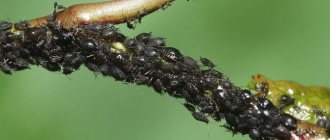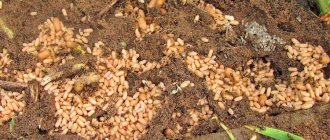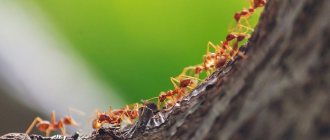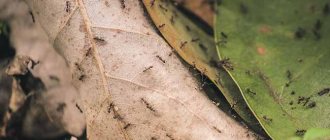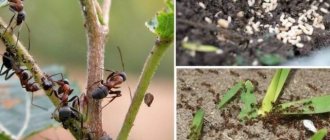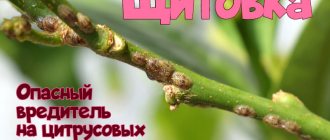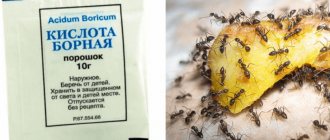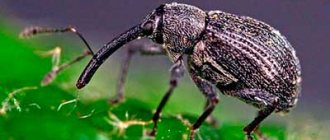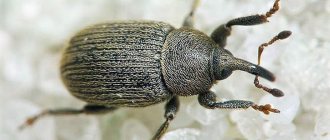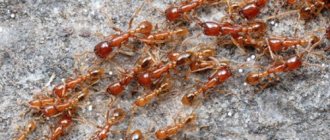The appearance of ants in the garden is an alarming sign. These hardworking insects are actually not as harmless as people who are not involved in plant growing think of them. Garden crops need protection from these little pests. If you find even one ant on the trunk of an apple tree or other fruit crop, you need to find out how to get rid of ants on trees and urgently take appropriate measures.
What kind of ants live on bushes and trees?
A large number of species and subspecies of these insects are already known. Ants are found in almost every corner of the planet. There are more than 260 species in our country.
Interestingly, ants adapt to all conditions. In nature, arthropods are important and are an integral part of the ecosystem, however, their presence on the site becomes a big problem for gardeners.
Ants do not live on bushes and trees, but graze aphids on them.
Ants do not live on trees and bushes, for them it is a kind of pasture, where little workers graze aphids together. Usually you can see small black ants in garden plantings, but the appearance of other types of these insects is no exception.
Are there varieties of apple trees that ants are not interested in?
The problem of the appearance of ants and the accompanying aphids is acute for all gardeners.
Therefore, professional breeders are tasked with breeding an apple tree variety that will not interest these insects. Currently, there is not a single variety of these fruit trees that are not affected by ants. After all, pests are attracted to an apple tree by many different factors, bypassing and eliminating which means radically changing the characteristics of the entire type of tree, which is so valued by consumers.
Harm and benefit
Ants bring considerable benefits to the garden plot. They destroy harmful insects such as:
- spider mite;
- thrips;
- various types of caterpillars;
- insect larvae.
The inhabitants of one large anthill can kill up to a kilogram of pests per day. These insects dig through many tunnels in the soil, thereby enriching it with oxygen and creating good conditions for the development and reproduction of beneficial microorganisms, thereby increasing the fertile layer.
Little workers fertilize the soil, filling it with phosphorus and potassium. It is estimated that in insect habitats the content of the first increases tenfold, and the second - twofold.
The ants themselves do not cause significant damage to trees and shrubs, unlike aphids - small pests for which arthropods have a special love.
Ants cause little damage to trees, unlike aphids.
More weeds grow in ant habitats. The fact is that insects carry with them the seeds of various plants, including weeds. Interestingly, ants like celandine seeds most of all.
Settling in the roots of trees, arthropods dig through many tunnels there, creating storerooms and carrying weed seeds into holes. During the period of ripening of fruits and berries, people with a sweet tooth do not mind enjoying the harvest and spoiling the already ripe fruits.
According to the author, garden ants cause harm by breeding aphids. They don’t spoil the harvest that much and don’t touch the trees, but they do eat caterpillars. Often it is completely useless to fight them, because to do this you need to treat the entire area with poisons.
Varieties
In the garden you can find only two types of ants: red and black. The habitat of the species is considered to be the entire territory of Eurasia to northeast China. Central Siberia is attacked only by black ants.
Redheads
They live in places where people are constantly present. The vegetable garden is not the best area for this type of ant. They prefer to settle near human habitation, but, of course, they will not refuse the juicy fruit of a pear or apricot. The colony settles in cracks under the house and grows quite quickly. Difficulties in etching them arise due to the presence of several queens. Accordingly, there are the same number of nests. Their moves unite. The lifespan of the uterus is up to 15 years. The speed of nest detection means peace of mind for the gardener.
Garden black
The color of the individual depends on the type of soil: from black to light yellow. There are also gray and brown ones, but the color does not affect the methods of destruction, because they are usually the same. Ants thrive on all types of soil. They survive in any conditions; temperature and climate do not affect the appearance of black garden ants.
TOP 15 best remedies for garden ants
In addition to the garden and vegetable garden, where the species feels good, the anthill can move into the house. The reason is fertility. Life expectancy is up to 28 years. They build their homes in the following places:
- soil (reaches 1 m deep);
- hollows;
- rotten wood;
- under stones;
- under the foundation of the house.
Reasons for the appearance of ants
The appearance of ants on fruit trees and shrubs is always accompanied by an invasion of aphids. They themselves are not so dangerous for the garden, since they do not feed on leaves and do not harm them. But aphids are the real cause of such a problem as leaf curling.
Arthropods graze entire colonies of aphids, collecting their secretions. Ants find honeydew (a sweet, sticky animal liquid) tasty. They happily feed on it themselves and bring it to the larvae and the queen. Individual individuals protect aphids, graze them and transfer them from one plant to another, expanding their unique pastures.
Since most often ants on bushes and trees appear due to aphids, therefore, in order to get rid of them in the garden, it is first necessary to eliminate the root cause.
Natural enemies
If we talk about natural conditions, then in the forest hedgehogs, frogs, lizards and other animals are not averse to feasting on goosebumps. It will not be possible to create such a zoo in vegetable gardens and orchards, and they will do more harm than good. Therefore, you have to rely on nature and luck, which will attract natural pest exterminators without damaging the garden.
Birds are not averse to eating goosebumps, they especially love larvae and will not bypass the queen. During the day you can often see a picture of a bird raking the soil and diligently looking for something; it is looking for these particular pests.
But you can’t count on their help, because with large concentrations of pests, more than one bird is needed, and the process of destroying anthills takes time, and we all know that birds don’t like to be neighbors with people, so their help will be minimal.
An antlion can be an ideal savior; this beetle is the most dangerous for pests and is capable of completely clearing an area of ants and other pests. If there is an opportunity to settle it on your site, this opportunity should not be missed.
Ways to protect trees
You can fight ants in the garden with folk remedies and chemicals. The first ones are more environmentally friendly, but less effective.
Ants in the roots
Nests in the roots of bushes or trees can harm the plant and future harvest. When starting pest control, you need to try to destroy all anthills on the site. To do this, the soil is dug up, and the trunks and soil around the plants are treated with lime mortar. The discovered nests are sprinkled with dry lime or ash.
You can protect trees in the garden by whitening the trunks in spring or autumn
Ants can be repelled from trees and shrubs by smell:
- bay leaf;
- anise;
- parsley;
- valerian;
- mint.
Repellent plants are laid out on ant paths or tied with stems around tree trunks. Places where insects are active can be watered with a solution of boric acid (1 tbsp) with sugar (2 tbsp).
To control tree roots, you can also use chemical control agents, for example, Ant. It is poured diluted directly into the nest. Pest control can also be carried out using dusts and pesticides. It is recommended to treat the anthill in the area of the roots of the green space with any preparation with an active insecticide - diazinon. In this case, death for insects occurs within a day or two. Products containing diazinon (Grom, Barguzin, Provotox) effectively destroy both adults and larvae.
Under the bark and in the trunk
Ants usually settle in damaged trunks or old diseased trees. In this case, you can get rid of ants as follows:
- Remove damaged wood along with insects.
- Treat cracks and holes with some insecticide.
- Cover problem areas with cement mortar.
- Dig up the infected tree, and then add diazinon to the soil.
Under the bark and in the trunk, insects are neutralized by coating the tree with various compounds, for example, black soap with kerasin.
By the way, cracks and hollows can be covered with clay mash with manure and copper sulfate (200 g of clay, 100 g of manure, a little copper sulfate, straw), which has a negative effect on ants.
Pest control on trees involves prevention and treatment of the entire area, not just focusing on problem areas. It should also be kept in mind that ants adapt to insecticides.
On flowers and fruits
On fruit trees inhabited by aphid colonies, there are always many ants present. Certain species of arthropods can:
- destroy the pistils and stamens of flowers;
- enjoy the juice of berries and fruits;
- gnaw the kidneys;
- spoil the bark of young plants and their roots.
To combat pests, protective barriers should be installed on the trunks, which are funnels made of dense material with a smooth surface. It can be roofing felt, cardboard or plastic. It is recommended to lubricate the inside with grease or Vaseline. Trees can also be protected with catching belts, which are metal rings that block insects from reaching the trees.
On the Internet you can find a statement that ants are able to make passages in the bark. This is a misconception - a healthy tree is too tough for pests. However, insects can use cracks, hollows and chips to move.
You can additionally protect flowers and fruits using the following methods:
- apply a ring of birch tar to the trunk;
- treat the tree with wormwood infusion (cold water (10 l) is poured into 30 g of dried or 300 g of fresh wormwood and left for several hours);
- put a foil skirt on the trunk (try to press the edge of the material as tightly as possible to the tree);
- use store-bought products such as Fufanon or Aktara (read the instructions carefully, the drugs are toxic).
Spraying the garden must be done before it blooms.
Video: how to make a hunting belt
Sintepon
A trap belt can be made from an old padding polyester taken out of a pillow or jacket. It will take at least 5 cm of material to secure it to the trunk or trunk of a fruit tree at a height of up to half a meter from the ground using twine. At the same time, beat the synthetic winterizer properly.
The rope should not be pulled too tightly to avoid constrictions on the bark.
It will be difficult for pests to overcome the obstacle; most of the ants will get entangled in it. At the same time, there is no need to use additional impregnations for padding polyester; this material is durable, does not rot, and dries quickly.
You can also form a funnel from padding polyester, with the edge directed up or down to collect ants. You should also make sure that there are no gaps between the belt and the trunk; it is advisable to cover them with clay.
How to protect seedlings
The presence of insects on the site can negatively affect the health of young plants, and the presence of anthills not far from the trunk can threaten damage to the root system. Experienced gardeners advise protecting seedlings with water. To do this, you will need a car tire, which should be cut in half lengthwise . The resulting gutters need to be placed around the plantings and dug in a little. Fill the tire halves with water.
The soil around young plants can be treated with infusions of hot pepper, snuff, celandine or dandelions . You can also place tomato shoots and garlic shoots around the seedlings. From these components it is permissible to prepare infusions that are used to cultivate the ground around planted trees:
- Place the crushed raw materials in glass, enamel or porcelain dishes.
- Fill with water.
- Close the lid and place in a water bath for fifteen minutes.
- After heating, allow the mixture to cool for an hour at room temperature, and then use as directed.
Garlic arrows will help protect seedlings from ants.
Of course, aphids should not be allowed to appear on young plants.
Ways to protect bushes
You can protect shrubs from aphids and ants by spraying them with garlic juice diluted with water (in a ratio of one to three). Yarrow is also effective; its leaves are placed between the branches. A decoction of wormwood or mint is also good at driving away ants and destroying aphids. The product can be used to treat plantings in dry weather using a sprayer or a broom. Gardeners advise trying to protect bushes from aphids with a weak solution of potassium permanganate and laundry soap (at the rate of one piece of grated soap per bucket of liquid).
Place bait with boric acid and sugar (can be replaced with jam, honey or boiled egg), mixed in equal proportions, between the bushes . You can treat the soil under the bushes with ammonia or a solution of molasses with yeast and even scatter pieces of herring between the branches. It is believed that ants cannot stand the smell of rotting fish.
Boric acid mixed with bait (sugar or honey) can fight a large number of ants
Monitor the health of your plants: aphids and, accordingly, ants are more often present on weak and diseased plantings.
Barrier method
Protecting trees from ants and aphids involves installing barriers at ground level.
- You will need an old car tire. It is cut into 2 parts. They dig a ditch under the tree, place a tire there, and secure it well with earth. Water is poured inside. Ants can't swim. A distance of 10 cm is insurmountable for them. Fruit trees and fruits are protected from invasion.
- You can get rid of ants and aphids with chalk. Scatter it near the tree and coat the trunk. Chalk particles stick to the legs of insects, depriving them of their tenacity. Pests simply fall from the tree, unable to reach the branches and damage young seedlings.
- To prevent ants from climbing the tree, tie foil around the trunk in the form of a skirt. Insects have difficulty crawling on slippery surfaces and are not flexible enough to overcome the sharp edges of the foil. The pests fall to the ground.
Trees can be saved in simple ways if taken care of in a timely manner.
Repellent plants
You can get rid of ants in the garden using natural repellents (they repel insects with a smell). Such plants are planted along the perimeter of the site or plantings. Typically, the following flora representatives are recommended for these purposes:
- lavender;
- fennel;
- dill;
- parsley;
- basil;
- cilantro;
- garlic;
- mint;
- marigold.
Photo gallery: plants that repel ants
Dill grows very well, so there will definitely be no ants on the site
Repellent plants don't have to be weeds
The pleasant smell of lavender will repel ants and delight the owners of the site
Processing of trunks
Professional preparations for insect pests provide a quick effect, but folk remedies are more environmentally friendly and harmless to fruit crops. Processing of trunks can be carried out in the following traditional ways:
- A thick mixture of table salt, soot, and linseed oil is applied to the bark in a dense layer of 15 cm (all components are taken in equal quantities);
- the trunks are coated with low concentration bleach, since excessive amounts harm the plants;
- Garlic repels ants, so the bark can be rubbed with cloves to ensure a lasting odor.
Prevention
This includes, first of all, getting rid of aphids. To do this, you need to regularly monitor the health of your garden. Sprinkle the crown (sprinkling water), mulch (cover the surface of the earth around the plants with any materials that regulate the water and air regimes of the fertile layer), as well as water and feed the plantings. It is necessary to wash off aphids and honeydew from the leaves .
Sprinkling the crown is an excellent measure to prevent the appearance of ants.
Particular attention should be paid to young shoots. It is recommended to promptly remove tops (powerful fattening shoots) and root branches. For prevention, the bark is cleaned in early spring or autumn. It is necessary to bleach the trunks regularly.
Planting repellent plants is an effective way to repel many types of ants . And plants such as parsley, dill and calendula also attract other insect predators that kill aphids:
- ladybugs;
- lacewing;
- ground beetles;
- bedbugs (some types);
- hoverflies;
- earwigs;
- os.
Birds actively destroy aphids. You can attract them to your site by feeding them and building houses. They feed on aphids:
- sparrows;
- kings;
- linnet;
- wrens;
- warblers;
- tits;
- robins.
Sparrows happily feast on aphids.
In my opinion, one of the most accessible and effective remedies against ants on trees (and not only) is medicinal chamomile, which can be purchased at any pharmacy. Many people have it growing on their property. This herb is non-toxic to humans and animals, but is very disliked by ants. The author treated areas with clusters of pests. The ants disappeared from the plantings within a few days. In addition, the author of the article successfully used unrefined sunflower oil, the aroma of which is also not liked by insects. Mixed it with water and poured it along the ant trails. After treatment, the latter left from under the bushes on the third day. Naturally, the mentioned means are far from the only effective ant repellers.
The safest and most humane way to get rid of these pests is to repel them with odors . The use of plants is a priority: they do not harm the health of people and their pets. At the same time, the pests remain safe and sound and simply leave the garden in search of other housing.
Ant Control: Traps
If traditional methods do not have the desired effect, but you still want to get rid of ants, then you can resort to traps. The most productive are considered: 1) Gel the great warrior; 2) Thunder two; 3) Clean house; 4) Anteater.
You can buy them in both hardware and garden stores. It is recommended to start using them even before the fruits begin to ripen. These methods are very similar to glue methods, but there is still a difference. The gels contain insecticidal elements. Naturally, insects take their particles to their shelter. They absorb it themselves, feed the larvae, and feed the queen. The family dies from this. That is, in about ten to fourteen days, the anthill will be gone.
You can coat the trunk with gel, or you can apply it to some object nearby. It retains its properties for about twenty days.
